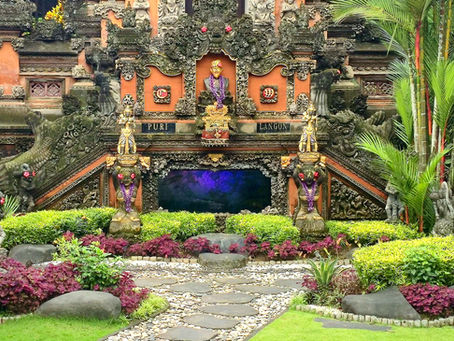top of page

GLOBAL SHANANIGANS

Search


The Holy Springs of Tirta Empul
Founded in 962AD during the Warmadewa dynasty, Tirta Empul is one of Bali’s most sacred temples, located in the cool highlands of Tampaksiring near Manukaya village. Its name, which means "holy water spring," is derived from a natural spring that bubbles up into the temple’s central pool and continues to feed the nearby Pakerisan River. This revered site is dedicated to Vishnu, the Hindu God of Water and Preservation
Shannon


Garuda - The Immortal Hunter
Garuda, the colossal bird being of Hindu myth, soars through Balinese religious imagination not as a gentle guardian but as a relentless force cutting across the realms of gods, demons and mortals. His wings are said to darken the sky when spread, the violent wind from their beat capable of stripping the leaves from the forests.
Shannon


Wat Chiang Man - Chiang Mai's Oldest Temple
Dating back to 1297, Chiang Mai’s oldest standing temple, Wat Chiang Man, was originally founded by King Mengrai as a royal encampment during the construction of his new capital. As the first temple within the city walls, it soon became a central hub for the emerging Lanna Kingdom, hosting religious ceremonies, political gatherings and significant social events, intertwining both spiritual devotion and civic life at the heart of the city.
Shannon


Dewi Danu and Dewi Sri – The Sacred Sisters of Bali
Dewi Danu rules the highland lakes while Dewi Sri dwells in the fertile lowlands, yet their powers meet within Bali’s sacred subak system. Waters from the mountains descend through canals to the rice fields, where temples serve as ritual gateways, transforming the flow of water and the growth of grain into a divine exchange between earth and goddess.
Shannon


Goa Lawah Bat Cave Temple
On Bali’s southeastern coast, Goa Lawah Bat Cave Temple stands out as a powerful spiritual site where myth and nature collide. With thousands of bats roosting above its shrines, this atmospheric temple offers a raw glimpse into the island’s ancient traditions.
Shannon


Cat Cat Village
Cat Cát Village lies in the misty mountains of northern Vietnam, known for its cascading waterfalls, terraced hillsides and narrow stone paths that wind through the valley. The landscape, shaped by water and cloud, gives the village a magical atmosphere that draws travellers seeking both beauty and stillness.
Shannon


Sacred Tombs of The Pagoda Forest
Located at the base of Mount Shaoshi in Henan Province, the Pagoda Forest at Shaolin Temple is a sacred necropolis within the broader monastery complex. With its origins tracing back to 618 AD during the Tang Dynasty, the forest is home to over 240 stone and brick pagodas, each serving as a tomb or memorial for esteemed monks, abbots and martial art masters.
Shannon


Kuanxiangzi Alley & The Blood Lantern Widow
Tucked into the vibrant heart of Chengdu, the capital of Sichuan Province, Kuanxiangzi Alley is a rare remnant of Qing Dynasty urban design, its origins reaching back over 300 years. Established in the late 17th century, the alley was constructed over an ancient military garrison and gradually developed into an elite residential area.
Shannon


Kanto Lampo Waterfall
Shaped by both chance and design, one of Bali’s most unexpected natural wonders is Kanto Lampo Waterfall. Unlike the island’s ancient cascades that have poured down jungle cliffs for centuries, this waterfall is a relatively recent creation. In the early 2010s, adjustments to a local irrigation system redirected water across a rocky cliffside and over time the flow carved its way over volcanic stone, giving rise to the unique cascade we see today.
Shannon


Ubud Water Palace
Built in honour of its namesake Saraswati, the Hindu goddess of knowledge, music, art, wisdom and learning, Pura Taman Saraswati is a graceful water temple nestled in the heart of downtown Ubud. This sacred site blends spiritual reverence with classical Balinese aesthetics, offering a peaceful retreat just steps away from the town’s busy centre.
Shannon


Tirta Gangga Water Palace
Nestled in the eastern highlands of Bali, in the quiet village of Ababi at the foot of Mount Agung, Tirta Gangga is a royal water palace steeped in beauty and spiritual reverence. Commissioned by the last Raja of Karangasem in 1946, this sacred estate pays homage to Balinese Hindu devotion. Its name, meaning “blessed water from the Ganges,” reflects its role as both a royal retreat and a site for spiritual purification and ceremonial bathing.
Shannon


Bao Lac
Bảo Lạc Town, near Vietnam’s northern border with China, hides a blood-soaked past beneath its calm surface. For centuries, this rugged land was home to fiercely independent Tày, Nùng, Hmong, and Dao tribes who lived and died resisting Vietnamese and Chinese domination. Imperial forces repeatedly tried to crush their autonomy, but the mountains ran red as rebellion flared again and again.
Shannon


Bedogol - The Gatekeepers
Across Bali, Bedogol refers to the guardian statues that flank the entrances of temples and family compounds, the silent watchers carved in stone. Positioned in pairs on either side of a gateway, they serve as spiritual protectors, anchoring the threshold between the ordinary world and sacred ground.
Shannon


Puri Langon Temple
Puri Langon is a privately owned royal compound located in central Ubud. It is the personal residence of Tjokorda Ngurah Suyadnya, better known as Cok Wah, a respected figure in the Ubud royal family. Though it remains a functioning private home, Puri Langon is open to the public free of charge, offering rare access to a lived-in royal space that continues to serve spiritual and cultural functions within the community.
Shannon


Hanoi Old Quarter
A living, breathing time capsule, Hà Nội Old Quarter is a tapestry woven from centuries of colonial exploitation, Confucian rituals, dynastic collapses and wartime destruction. Despite relentless modernisation and gentrification, the Old Quarter remains defiantly alive. It preserves not just Hà Nội’s heritage but the very essence of Vietnam’s ability to adapt and endure.
Shannon


Batara Kala - Devourer of Time and Light
Batara Kala, in Balinese mythology, is the monstrous deity of time, destruction and the underworld. He's a god born not from light but from the uncontrolled lust of the supreme god Shiva (Siwa). In one chilling version of his origin, Batara Kala is conceived during a moment of cosmic imbalance, when Shiva’s spilled seed, filled with uncontrollable rage and passion, falls to earth and takes form.
Shannon


Thailand's Golden Triangle
The Golden Triangle snakes along the borders of Thailand, Laos and Myanmar, a land as beautiful as it is brutal. The Mekong River twists like a silver serpent through shadowed valleys, past isolated villages whose fields once fed a global hunger for heroin. This rugged, turbulent region earned its infamous name from centuries of opium fueled violence and despair. More than a crossroads, the Golden Triangle is a nexus of greed, pain and heartbreak.
Shannon


Beyond the Mist - Exploring Sapa
Tucked high in the Hoàng Liên Son Mountains of northwestern Vietnam, Sapa’s history predates the modern tourism boom by centuries. Archaeological discoveries suggest that humans have inhabited this rugged region for thousands of years. Stone tools, ceramic fragments and burial items uncovered in the Muong Hoa Valley point to a Neolithic culture that once thrived along the riverbanks. These finds, some dating back 3000 years, are among the earliest signs of life in Vietnam’s m
Shannon


Inside the Puputan - Bali's Bloody Resistance
The Dutch first reached Bali in 1597 while scouting new ground for conquest and profit. They left without drawing blood but they didn’t leave without a decision. Bali had been marked. For the next two centuries, the island remained untouched, not because the Dutch had lost interest, but because they were waiting for the moment it would be worth the slaughter. It wasn’t peace. It was a pause before an extermination. When they returned, the rivers would turn red.
Shannon


Ho Chi Minh Museum
The Ho Chi Minh Museum in Hanoi is more than a museum, it is a shrine to revolution, memory and sacrifice, standing as one of Vietnam’s most important monuments. It honours the man known as “Uncle Ho” while also serving as a vast archive of the struggles that shaped modern Vietnam, a place where personal biography and national trauma merge into a single, powerful narrative.
Shannon
bottom of page